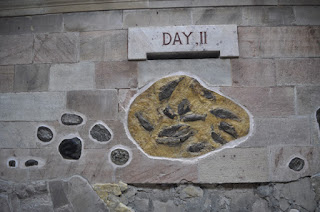Biddulph Grange has a very unique Geology Gallery which was designed in Victorian times to represent the 6 days of creation in fossils. The seventh day is represented by walking out into the extensive garden. It is currently being restored to its original condition.
The gallery and gardens were designed by James Bateman with the help of his friend Edward Cooke. James and Maria moved into the Grange in 1840, shortly after their marriage. The gallery and gardens were completed by 1860, but the financial burden of the work was a significant issue and in 1868, the house was passed on to their son, who very quickly put the property up for sale to a wealthy industrialist. The house and gardens are currently managed by the National Trust.
The gallery is arranged in days, with suitable fossils fixed into the wall to represent the development of life. Day one shows largely Cambrian and Ordovician fossils.
Day two is representing the start of vertebrate fossils and the development of smaller species within the seas. And these fossils progress to more complex and recent forms by day six.
An additional slab has been added out of the main sequence to show a piece of lithographic limestone from Bavaria. These fossils were becoming available after the wall was completed and this one was either purchased from a quarry site in Germany or from a fossil dealer in London. There is no record of the purchase, but the fossil appears to have been in place during Batemans time at the Grange. The original has been retained after many of the fossils were sold off. The National Trust is now in the process of restoring the original gallery, using casts of the original fossils where possible.
This fossil is of interest to me since it is unrecorded and shows two fragments of pterosaur material. A skull fragment of pterodactylus and a spinal associated group of fossil bones from a pterosaur which is provisionally associated with germanodactylus.
Biddulph Grange Gardens is a worthwhile visit, offering an unusual collection of plants.






No comments:
Post a Comment